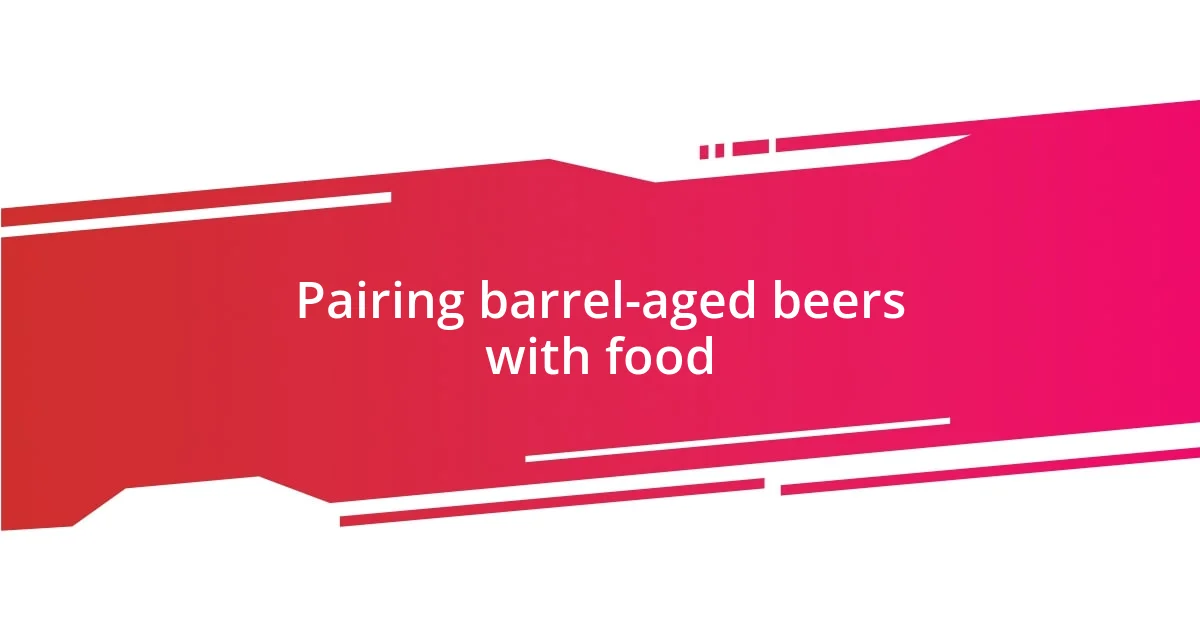Key takeaways:
- The author’s beer journey evolved from basic light lagers to a deep appreciation for complex flavors, particularly through experiences with barrel-aged beers.
- Barrel aging introduces intricate flavor profiles influenced by the type of barrels used, enhancing the sensory experience of beer.
- Pairing barrel-aged beers with food creates memorable experiences, highlighting the importance of flavor combinations and personal connections in beer appreciation.

My journey to beer appreciation
My beer journey began in my college days, where I thought a cold light lager was the pinnacle of sophistication. I still remember my first sip of a darker brew at a friend’s gathering – the flavors danced on my palate in a way that no fizzy beer ever had. Could it be that there was more to beer than just getting a buzz?
As I explored local breweries, I stumbled upon a barrel-aged stout that changed everything. The aroma was intoxicating; hints of chocolate and vanilla wrapped around me like a warm blanket. I felt an exhilarating rush that made me realize beer could be an experience, not just a drink. Have you ever truly savored a flavor that took you on a journey?
I found myself attending tastings, eager to learn the intricacies of brewing. Listening to artisans share their passion made me appreciate the craft behind each pint. It was like unlocking a treasure chest of flavors, and every sip was a new discovery, teaching me that beer can be as complex as a fine whiskey or a rich red wine. Isn’t it fascinating how a simple beverage can open doors to such depth and community?

Discovering barrel aging technique
Discovering the barrel aging technique was like unearthing a hidden gem in the vast world of brewing. I remember the moment vividly—I walked into a quaint brewery and was greeted by the rich smell of wood and malt. It was there the brewer explained how aging beer in oak barrels, often previously used for bourbon or wine, infuses the beer with intricate flavors that can’t be achieved through regular brewing. I was hooked by the thought that this ancient practice could transform something so familiar into an extraordinary sensory experience.
As I delved deeper, I learned that barrel aging is not just about enhancing flavor; it’s a delicate dance of time and patience. My first taste of a barrel-aged barleywine blew me away—the smoothness was unlike anything I had ever indulged in. Each sip carried the depth of the wood and the warmth of the spirits it once held. Have you ever encountered a drink that evoked emotion? That’s what barrel aging does; it tells a story through its complexity and character.
I’ve come to appreciate how different types of barrels can yield vastly different results, creating unique flavor profiles. It’s like being a kid in a candy store, where each barrel brings its own surprises. For example, the influence of a whiskey barrel might shine with caramel notes, while a wine barrel might introduce fruity undertones. This variety keeps my taste buds excited and constantly learning. Isn’t it exhilarating to think about the endless possibilities within a single brewing technique?
| Barrel Type | Flavor Profile |
|---|---|
| Bourbon Barrel | Sweet, caramel, vanilla, oak |
| Wine Barrel | Fruity, tannins, floral notes |
| Rum Barrel | Spicy, molasses, tropical notes |
| New Oak Barrel | Bold, woody, intense |

Understanding flavor profiles in beers
Understanding flavor profiles in beers is quite an enlightening journey, especially when you start noticing the subtle differences in each brew. During one of my brewery visits, I was captivated by an explanation about how the choice of ingredients and brewing methods influences the final flavor profile. It’s fascinating to think that a single hop variety can bring notes of citrus or floral tones, while malt can evoke toasty, caramel flavors. I still recall a pale ale that sang with grapefruit brightness. It felt like summer in a bottle!
Here are some key aspects to consider when exploring beer flavor profiles:
- Hops: Different varieties can produce bitterness and aromas, ranging from floral to piney to fruity.
- Malts: The roasted grains give beer color and flavor. They often lean towards sweet, nutty, or chocolatey profiles.
- Yeast: This ingredient plays a crucial role in fermentation, contributing esters that can make a beer fruity or spicy.
- Water Chemistry: The mineral content in water influences the mouthfeel and clarity of the beer.
- Barrel Aging: As I’ve learned, wood can add layers of complexity through tannins and other compounds from the previous contents.
As I continued my exploration, I realized that certain beers can evoke strong feelings and memories. I remember tasting a sour ale that instantly transported me back to a summer picnic with friends, where laughter and sunlight danced in the air. It was vivid moments like this that deepened my connection to beer, turning each sip into a nostalgic experience. So, whether you’re enjoying a crisp lager or a rich stout, think about the flavors at play; they’re all part of a beautiful tapestry crafted by the brewers’ hands.

Types of barrel-aged beers
When it comes to barrel-aged beers, the variety is truly remarkable. From my experience, bourbon barrel-aged beers often showcase rich, sweet flavors that evoke warmth and comfort. I still vividly remember sipping on one during a chilly autumn evening, the caramel and vanilla notes wrapping around me like a cozy blanket. Can a beer really make you feel that way? I believe it can.
On the other hand, wine barrel-aged beers bring a different kind of magic to the table. The first time I tried a sour ale aged in a Cabernet barrel, I was taken aback by the delicate floral notes intertwined with fruity, tart hints. It was as if I had bitten into a fresh berry on a sunlit day, invigorating and refreshing. This experience made me ponder how these barrels, once the vessel of fine wines, could impart such vibrant characteristics to beer.
Rum barrel-aged beers, while less common, are a delightful surprise as well. I recall tasting a beer that had spent time in a rum barrel, and it transported me to a tropical paradise with its hints of molasses and spice. It was a reminder that the journey of barrel aging is like traveling to far-off lands with every sip. Have you found yourself captivated by an unexpected flavor? It’s the little surprises that make this exploration endlessly enjoyable.

Tasting notes of my favorites
The first barrel-aged beer that truly captured my heart was a Russian Imperial Stout that had a profound coffee aroma interlaced with chocolate and hints of dark fruit. I remember sitting around a fire pit one winter night, each sip warming me from the inside out while the complex flavors unfolded like a rich story. It was a moment of pure bliss, making me ponder – can flavors really evoke such warmth and connection? I believe they can.
Then, there was this fascinating Belgian-style Dubbel that had been aged in a whiskey barrel. The first taste was a revelation; the malty sweetness mingled beautifully with the oak and subtle spice, sending my taste buds into a frenzy. I distinctly recall sharing it with a friend who had never tried barrel-aged beers before. His expression of surprise and delight reminded me how magical the right beer can be, prompting me to think—how can a simple beverage create such joy?
Lastly, a cherry wood-aged sour ale left an imprint on my memory. It unfurled a delightful mix of tartness complemented by soft, woody notes. I vividly remember the warm summer afternoon I enjoyed it at a local craft festival, surrounded by good friends and laughter. That beer didn’t just quench my thirst; it woven a memory of enjoyment, bringing to life the question—how much of our love for beer is tied to the experiences we create with it? I would argue it’s a significant part of the equation.

Pairing barrel-aged beers with food
Pairing barrel-aged beers with food is an adventure in itself. I remember the first time I paired a bourbon barrel-aged ale with a rich chocolate dessert. The way the beer’s sweet caramel tones melded with the bitterness of the chocolate sent my taste buds into a delightful frenzy. Have you ever experienced a pairing that just clicked? It’s moments like these that make me appreciate the thoughtful combinations of flavors even more.
Cheeses also play a fantastic role in these pairings. I fondly recall a night spent sampling a nectarous rum barrel-aged beer alongside a sharp blue cheese. The creaminess of the cheese softened the beer’s boldness, while the hints of molasses danced gracefully on my palate. It made me wonder if there’s a more perfect pairing than the union of cheese and beer. Could this be the kind of harmony that elevates our dining experiences?
Then there’s the magic of savory dishes. I once experimented by enjoying a smoky stout with barbecue ribs, and it was nothing short of transformative. The way the robust flavors entwined created a hearty symphony of taste that felt almost celebratory. I was left asking myself—how do certain flavors make us feel more alive? For me, a well-thought-out pairing can turn a simple meal into a memorable occasion, igniting connections and conversations over a shared love for great beer.

Tips for exploring new beers
Exploring new beers is an exciting journey, and I recommend starting with local breweries. I remember the first time I stepped into a small craft brewery. The atmosphere was vibrant, and the staff were eager to share their passion, even offering a flight of tasters that introduced me to flavors I’d never expected. Have you ever tasted a beer that completely changed your perception? That experience opened my eyes to the endless possibilities beyond mainstream options.
Don’t shy away from asking the staff for recommendations based on your current favorites. A friendly server once suggested a barrel-aged porter to me after I expressed my love for stouts. Their enthusiasm about the beer was infectious, and I got to savor a complex brew that mixed chocolate, coffee, and a subtle smokiness. It made me wonder—how often do we discover hidden gems when we engage with passionate individuals in the beer community?
Lastly, keep a beer journal. After trying a particularly interesting sour ale, I decided to jot down my thoughts and flavor notes. This not only helped me remember what I loved but also allowed me to track my evolving taste preferences. Have you considered how writing can deepen your connection to your experiences? It’s like crafting your own personal map through the world of beer, guiding you to revisit favorites and seek out new adventures in every pour.















